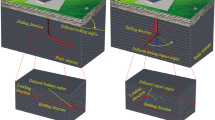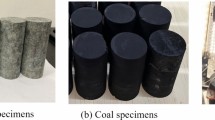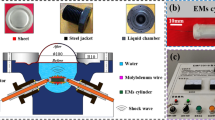Abstract
Cyclic loading, when acting upon a structure due to natural or man-made causes, deteriorates its strength slowly. This phenomenon might result in fatigue failure, which is often catastrophic and sudden. Such failure can also occur in underlying rocks over which civil structures are built. It is very crucial to identify the damage in the surrounding rocks at an incipient stage to prevent its further propagation and safeguard the structure built over it. However, unlike superstructure, the underlying rocks are often inaccessible for conventional monitoring techniques. Therefore, damage detection in rocks requires an efficient and dedicated structural health monitoring (SHM) system to monitor the rocks regularly. The present study explores the feasibility of using thin piezo-based sensors via the electro-mechanical impedance (EMI) technique for timely detecting damages in rocks under cyclic loading. As part of the experimental program, cylindrical specimens of Kota sandstone, instrumented with lead zirconate titanate (PZT) patches, were tested under sinusoidal cyclic loading. The conductance signatures acquired at different stages of loading were analyzed, and changes resulting from damage were quantified using sub-root mean-square deviation (S-RMSD) technique. The frequency range of 1–100 kHz was found to be most sensitive toward detecting the incremental damages in rocks with an increase in the number of cycles. The patches were capable of detecting the damage even after the first 1000 cycles of loading. The shifting of the conductance peak indicated the reduction in the stiffness of the rock specimen. The results of the study confirm the feasibility of the EMI technique for SHM of rocks under cyclic loading.











Similar content being viewed by others
References
Alam MS, Chakraborty T, Matsagar V, Rao KS, Sharma P, Singh M (2015) Characterization of kota sandstone under different strain rates in uniaxial loading. Geotech Geol Eng 33:143–152. https://doi.org/10.1007/s10706-014-9810-3
Araldite (2019) Araldite standard product catalogue. http://www.go-araldite.com/products/epoxy-adhesives/araldite-standard-2-x-15ml-tube. Accessed 15 Jan 2019
Asakura T, Kojima Y (2003) Tunnel maintenance in Japan. Tunn Undergr Space Technol 18:161–169
ASTM International (2004) ASTM D6914-04, standard practice for sonic drilling for site characterization and the installation of subsurface monitoring devices, International, West Conshohocken, PA. https://www.astm.org/
ASTM International (2014) ASTM F3079-14, standard practice for use of distributed optical fiber sensing systems for monitoring the impact of ground movements during tunnel and utility construction on existing underground utilities, ASTM International, West Conshohocken, PA. https://www.astm.org/
Atkinson BK (1984) Subcritical crack growth in geological materials. J Geophys Res Solid Earth 89:4077–4114
Attewell PB, Farmer IW (1973) Fatigue behaviour of rock. Int J Rock Mech Min Sci 10:1–9
Ayres III JW, Lalande F, Rogers CA, Chaudhry ZA (1996) Qualitative health monitoring of a steel bridge joint via piezoelectric actuator/sensor patches. Proc. SPIE 2946, Nondestructive Evaluation of Bridges and Highways. https://doi.org/10.1117/12.259139
Bhalla S (2004) A mechanical impedance approach for structural identification, health monitoring and non-destructive evaluation using piezo-impedance transducers. PhD Thesis, NTU, Singapore
Bhalla S, Kaur N (2018) Prognosis of low-strain fatigue induced damage in reinforced concrete structures using embedded piezo-transducers. Int J Fatigue 113:98–112
Bhalla S, Soh CK (2004) High frequency piezoelectric signatures for diagnosis of seismic/blast induced structural damages. NDT E Int 37:23–33
Bhalla S, Soh CK (2004) Structural health monitoring by piezo-impedance transducers. I: modeling. J Aerosp Eng 17:154–165
Bhalla S, Vittal PA, Veljkovic M (2012) Piezo-impedance transducers for residual fatigue life assessment of bolted steel joints. Struct Health Monit 116:733–750
Bhalla S, Moharana S, Talakokula V, Kaur N (2017) Piezoelectric materials applications in SHM, energy harvesting & biomechanics. Athena Academic & Wiley
Costin LS, Holcomb DJ (1981) Time dependent failure of rock under cyclic loading. Tectonophysics 79:279–296
Dauskarat RH, Marshall DB, Ritchie RO (1990) Cyclic fatigu crack propagation in magnesia partially stabilized zirconia ceramics. J Am Ceram Soc 73:893–903
Divsholi BS, Yang Y (2012) Health monitoring of steel structures using sub-frequency electromechanical impedance technique. J Nondestruct Eval 31:197–207
Giurgiutiu V, Rogers CA (1998) Recent advancements in the electromechanical (E/M) impedance method for structural health monitoring and NDE. Proc SPIE Int Soc Opt Eng 3329:536–547
Giurgiutiu V, Reynolds A, Rogers CA (1999) Experimental investigation of E/M impedance health monitoring for spot-welded structural joints. J Intell Mater Syst Struct 10:802–812
Keysight (2019). http://www.keysight.com/en/pd-715495-pn-E4980A/precision-lcr-meter-20-hz-to-2-mhz?cc=IN&lc=eng. Accessed 15 Jan 2019
Lee J, Wang C, Ho Y, Huang A (2013) Characterization of reservoir sediment under water with differential pressure-sensored flat dilatometer and piezo-penetrometer. Acta Geotech 8:373–380. https://doi.org/10.1007/s11440-012-0188-1
Liang C, Sun FP, Rogers CA (1994) Coupled electro-mechanical analysis of adaptive material systems-determination of the actuator power consumption and system energy transfer. J Intell Mater Syst Struct 5:12–20
McCann DM, Forde MC (2001) Review of NDT methods in the assessment of concrete and masonry structures. NDT E Int 34:71–84
Moharana S, Bhalla S (2012) Numerical investigations of shear lag effect on PZT-structure interaction: review and application. Curr Sci 103:685–696
Na S, Lee HK (2012) A technique for improving the damage detection ability of the electro-mechanical impedance method on concrete structures. Smart Mater Struct 21:85024
Negi P, Chakraborty T (2018) Feasibility of thin piezo based transducers for acquiring EMI signatures and acoustic emissions. In: Paper presented at the ISRM International Symposium—10th Asian Rock Mechanics Symposium, Singapore, October 2018
Negi P, Chakraborty T, Bhalla S (2017) Damage monitoring of dry and saturated rocks using piezo transducers. J Test Eval 45:20160158
Park G, Cudney H, Inman D (2000) Impedance-based health monitoring of civil structural components. J Infrastruct Syst 6:153–160
Park G, Cudney HH, Inman DJ (2001) Feasibility of using impedance-based damage assessment for pipeline structures. Earthq Eng Struct Dyn 30:1463–1474
Park G, Sohn H, Farrar CR, Inmam HJ (2003) Overview of piezoelectric impedance-based health monitoring and path forward. Shock Vib Dig 35:451–463
Park S, Ahmad S, Yun CB, Roh Y (2006) Multiple crack detection of concrete structures using impedance based structural health monitoring techniques. Exp Mech 46:609–618
PZT5A & 5H Materials Technical Data (2019). http://www.ctscorp.com/components/pzt/downloads/PZT_5Aand5H.pdf. Accessed 15 Jan 2019
Stavrogin AN, Tarasov BG (2001) Experimental physics and rock mechanics. CRC Press
Sun FP, Chaudhry ZA, Rogers CA, Majumdar M, Liang C (1995) Automated real-time structure health monitoring via signature pattern recognition. Proc. SPIE 2443, Smart Structures and Materials 1995: Smart Structures and Integrated Systems. https://doi.org/10.1117/12.208261
Tobita J, Fukuwa N (2009) Ground vibration caused by tunnel construction and its effect on an electron microscope. J Asian Archit Build Eng 8:267–273
Wang D, Zhu H (2011) Monitoring of the strength gain of concrete using embedded PZT impedance transducer. Constr Build Mater 25:3703–3708
Wang B, Huo L, Chen D, Li W, Song G (2017) Impedance-based pre-stress monitoring of rock bolts using a piezoceramic-based smart washer—a feasibility study. Sensors 17(2):250
Wang F, Konietzky H, Frühwirt T, Dai Y (2020) Laboratory testing and numerical simulation of properties and thermal-induced cracking of Eibenstock granite at elevated temperatures. Acta Geotech. https://doi.org/10.1007/s11440-020-00926-8
Yang Y, Divsholi BS (2010) Sub-frequency interval approach in electromechanical impedance technique for concrete structure health monitoring. Sensors 10:11644–11661
Yang Y, Xu J, Soh CK (2005) Generic impedance-based model for structure-piezoceramic interacting system. J Aerosp Eng 18:93–101
Yang YW, Bhalla S, Wang C, Soh CK, Zhao J (2007) Monitoring of rocks using smart sensors. Tunn Undergr Space Technol 22:206–221
Yang Y, Hu Y, Lu Y (2008) Sensitivity of PZT impedance sensors for damage detection of concrete structures. Sensors 8:327–346
Yang Y, Annamdas VGM, Wang C, Zhou Y (2008) Application of multiplexed FBG and PZT impedance sensors for health monitoring of rocks. Sensors 8:271–289
Yang Y, Divsholi BS, Soh CK (2010) A reusable PZT transducer for monitoring initial hydration and structural health of concrete. Sensors 10:5193–5208
Author information
Authors and Affiliations
Corresponding author
Additional information
Publisher's Note
Springer Nature remains neutral with regard to jurisdictional claims in published maps and institutional affiliations.
Rights and permissions
About this article
Cite this article
Negi, P., Chakraborty, T. & Bhalla, S. Viability of electro-mechanical impedance technique for monitoring damage in rocks under cyclic loading. Acta Geotech. 17, 483–495 (2022). https://doi.org/10.1007/s11440-021-01181-1
Received:
Accepted:
Published:
Issue Date:
DOI: https://doi.org/10.1007/s11440-021-01181-1




